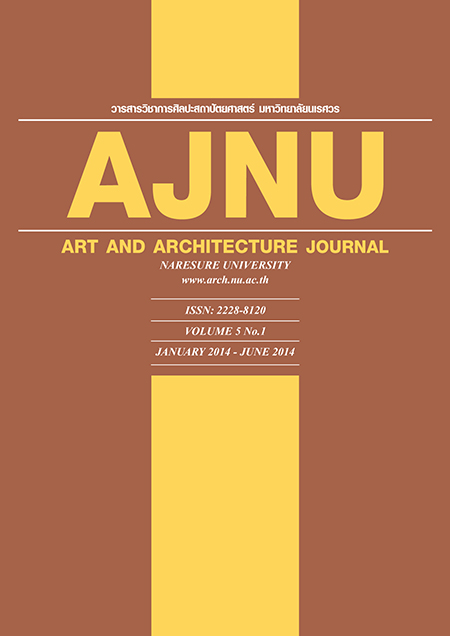การศึกษาแนวทางการแปรรูปวัสดุเหลือใช้จากอุตสาหกรรมกระดาษ
Main Article Content
Abstract
วิจัยนี้มีวัตถุประสงค์เพื่อศึกษาคุณสมบัติและพัฒนากระบวนการผลิตวัสดุทดแทนที่ทำจากเศษวัสดุเหลือใช้จาก การตัดไม้ยูคาลิปตัสในกระบวนการผลิตของอุตสาหกรรมกระดาษเพื่อนำมาพัฒนาเป็นวัสดุร่วมสมัยและผลิตภัณฑ์ โดยใช้เศษ เปลือกไม้และเศษฝุ่น ซึ่งใน บริษัทฟินิกซ์ พลัพ แอนด์ เพเพอร์ จำกัด มหาชน (SCG) เป็นโรงงานอุตสาหกรรมกระดาษขนาด ใหญ่ ทำให้มีเศษฝุ่นเหลือใช้จากการผลิต 37 ตัน/วัน เศษเปลือก 112 ตัน/วัน โดยการนำเศษเปลือกไม้และเศษฝุ่นยูคาลิปตัสมา อัดขึ้นรูปแบบแผ่น และผลวิจัยพบว่า สูตรกาวที่ใช้ในการทดลองมีอยู่ 2 สูตร คือ (1)กาวประสานที่ได้จากการละลายพลาสติก ขาวใสในน้ำมันเบนซิน โดยใช้กาว 60% เศษเปลือกฝุ่นไม้ยูคาลิปตัส 40% อัดเย็นลงในแม่พิมพ์ นาน 30 นาที ที่แรงกด 1,000 กิโลกรัมต่อตารางเซนติเมตร (2) เศษฝุ่นไม้ยูคาลิปตัสต่อกาวประสานที่ได้จากการเทเคลือบด้วยเรซิน โดยใช้เรซิ่น 60% เศษฝุ่น ไม้ยูคาลิปตัส 40% เทลงในแม่พิมพ์ นาน 3 ชั่วโมง รอให้เศษฝุ่นไม้และตัวประสานแห้งเป็นแผ่น การวิเคราะห์ตามมาตรฐาน ผลิตภัณฑ์อุตสาหกรรมแผ่นชิ้นไม้อัดชนิดอัดราบ(มอก.876-2547) พบว่าแผ่นวัสดุทดแทนไม้จากเศษเปลือกไม้ สูตรที่1 มีค่า ความชื้นที่ (Moisture content) 7.41 (2.)ความหนาแน่นที่(Density) 0.71 (3.) การพองตัวตามความหนาที่(Thickness Swelling) 2.56 และมีค่าคุณสมบัติเชิงกล คือ 4. ค่าสัมประสิทธิ์การแตกหัก(MOR) ที่ 5.32 (5.) ค่าสัมประสิทธิ์การยืดหยุ่น (MOE) ที่ 611.62 (6.) ความต้านแรงดึงตั้งฉากกับผิวหน้า(Internal Bonding) 1.00 ซึ่งมีอยู่ 2 คุณสมบัติ ที่ไม่ผ่านไปตาม เกณฑ์มาตรฐานคือ 4. ค่าสัมประสิทธิ์การแตกหัก(MOR) มีค่า 5.32 MPa ซึ่งต่ำกว่าเกณฑ์ที่กำหนดไว้ คือไม่น้อยกว่า 14 และ 5. ค่าสัมประสิทธิ์การยืดหยุ่น(MOE) มีค่า 611.62 MPa ซึ่งต่ำกว่าเกณฑ์ที่กำหนดไว้ คือไม่น้อยกว่า800, สูตรที่2 เศษฝุ่นไม้ยูคา ลิปตัส มีค่า1. ความชื้นที่(Moisture content) 0.61 (2.)ความหนาแน่น(Density)ที่ 1.15 (3.) การพองตัวตามความหนา (Thickness Swelling) ที่ 1.26 และมีค่าคุณสมบัติเชิงกล คือ (4.) ค่าสัมประสิทธิ์การแตกหัก(MOR)ที่ 16.90 (5.) ค่าสัมประสิทธิ์ การยืดหยุ่น(MOE) ที่ 2078.22 (6.) ความต้านแรงดึงตั้งฉากกับผิวหน้า(Internal Bonding) 0.69 ผ่านทั้งหมดทุกข้อคุณสมบัติ เป็นไปตามเกณฑ์มาตรฐานผลิตภัณฑ์อุตสาหกรรมแผ่นชิ้นไม้อัดชนิดราบ (มอก.876-2547) ที่กำหนดไว้ และสามารถนำมาผลิต และพัฒนาเป็นผลิตภัณฑ์ร่วมสมัยอีกทางหนึ่ง
A Study on the processing waste from the paper industry
This study is aimed at studying qualification and developing the process of renewable materials made from scraps of Eucalyptus woodcutting in the process of paper industry to develop for materials and contemporary products by using scraps of barks and dust. In the Phoenix Pulp & Paper Public Company Limited (SCG), the large paper industry, the company provides 37 tons of dusk per day and 112 tons of bark scrap per day. The company uses those scraps of barks and dust in the process of sheet extrusion. The result from the study, it is found that there are two glue formulas: (1) an adhesive from the dissolution of white plastic in gasoline by using 60% of glue and 40% of scraps of Eucalyptus barks and dust processing in a cold press process into a mold for 30 minutes at pressure 1,000 km/m2 (2) ratio of scraps of Eucalyptus barks and adhesive from pouring glaze by resin by using 60% of resin and 40% of scraps of Eucalyptus barks poured into the mold for 30 minutes until it sets as a sheet. The analysis from the standard of flat pressed particleboard product industry (TIS 876-2547) has found that the renewable material from scrap of barks, the first formula has moisture 7.41 %, 2. density 0.71 kg/cb.m, 3. thickness swelling 2.56, and mechanical properties: 4. bending strength-modulus of rupture (MOR) 5.32 Mpa, 5. Stiffness-modulus of elasticity (MOE) 611.62 Mpa, and 6. Internal Bonding 1.00. All of those, there are only two unsatisfied qualifications: 4. bending strength-modulus of rupture (MOR) 5.32 Mpa which is less than the criteria that no less than 14 Mpa, and 5. Stiffness-modulus of elasticity (MOE) 611.62 Mpa which is less than the criteria that no less than 800 Mpa. The second formula, scraps of Eucalyptus barks has moisture 0.61 %, 2. density 1.15 kg/cb.m, 3. thickness swelling 1.26, and mechanical properties: 4. bending strength-modulus of rupture (MOR) 16.90 Mpa, 5. Stiffness-modulus of elasticity (MOE) 2078.22 Mpa, and 6. Internal Bonding 0.69, all qualifications are satisfied by the criteria that the standard of flat pressed particleboard product industry (TIS 876-2547) has specified and the product can be produced and developed to contemporary products.


